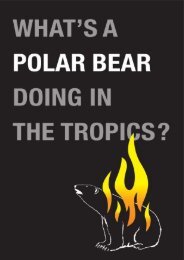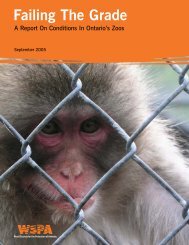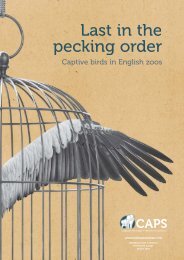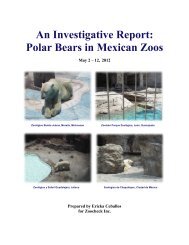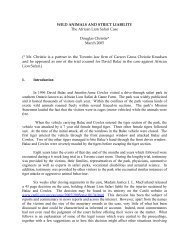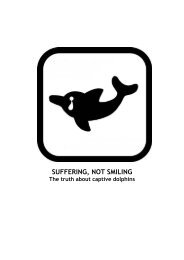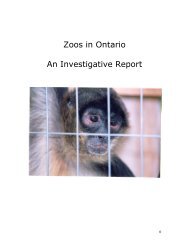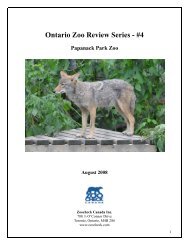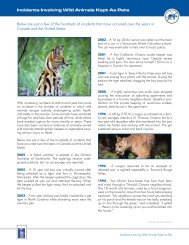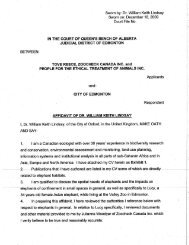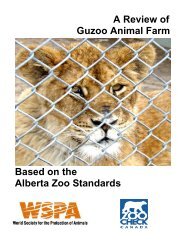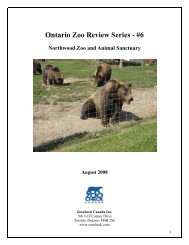STATUS OF BEAR WELFARE
STATUS OF BEAR WELFARE
STATUS OF BEAR WELFARE
You also want an ePaper? Increase the reach of your titles
YUMPU automatically turns print PDFs into web optimized ePapers that Google loves.
Status of Bear Welfare in Cherokee, North Carolina<br />
Photo 9C of a bear in the Marge/Elvis pit at CBZ shows that the left forepaw, main pad, has a<br />
deep crack, and the outside toe pad has a wear point. A black bear at CSBP showed a lesion on<br />
the left forepaw and the second-to-last outside toe pad.<br />
Photo 9D of a bear in the Marge/Elvis pit at CBZ shows the left rear paw. The main footpad has<br />
deep cracks, and the outside toe pad appears to be raw.<br />
Photo 9E of an Asiatic black bear at CSBP shows a pink area on the rear left footpad that may<br />
indicate a wear point.<br />
Claws<br />
The claws of the bears, most notably the grizzlies, were worn down to the point where they met<br />
the ground. These claws are substantially longer in free-ranging wild bears and captive bears<br />
housed on suitable substrates. Photos 10A and 10B show the worn-down claws of the captive<br />
bears in Cherokee versus normal claws in 10C. Although this reduced claw length is not itself a<br />
problem, it illustrates that material hard enough to chisel claws down to half their length will wreak<br />
havoc on the softer footpads that must endure this hard abrasive material day after day.<br />
Osteoarthritis<br />
Bears who are kept on concrete and other unyielding surfaces such as hard, compacted earth are<br />
subject to the premature development of arthritis. Micro-traumas that occur over time, associated<br />
with repetitive movements, overuse, and/or overloading of the musculoskeletal system, set these<br />
bears up for progressive cartilage loss, inflammation, and bony changes in their neck, spine, and<br />
joints. The chronic pain associated with osteoarthritis further limits mobility in these already<br />
exercise-deprived bears, which leads to more weight gain.<br />
Obesity, immobility, and chronic stress precipitate circulatory problems, which lead to chronic<br />
infections, and another vicious cycle is created. Chronically infected feet also lead to<br />
osteomyelitis and breakdown of the bones of the feet, a condition that often leads to euthanasia.<br />
Obesity, Poor Muscle Tone, and Nutritional Concerns<br />
All the bears observed had poor muscle tone. At CSBP, two of the Asiatic black bears (photo<br />
11A) and several of the adult black bears (photo 11B) and a black bear at CBZ (photo 5) were<br />
notably overweight or obese. A grizzly at CBZ was notably thin (photo 11C). As the maintenance<br />
of muscle mass is contingent on proper exercise, even bears who fall into normal parameters for<br />
weight will have significantly less muscle mass and tone when compared to their wild cousins.<br />
Dog chow, white bread, iceberg lettuce, apple slices, and sugary drinks are not a nutritionally<br />
complete diet for bears who require a wide variety of seasonally available foods such as whole<br />
fruits, berries, vegetables, tubers, nuts, browse with bark, some fish, and whole carcasses. In<br />
fact, government inspectors have recognized similar improper diets on inspection reports for<br />
other licensees, writing, “Bears in captivity are developing health problems due to the large<br />
amount of sweets that they are being offered,” and “Dog food is not a complete nutritional diet for<br />
bears.” 13,14<br />
AN INVESTIGATIVE REPORT <strong>OF</strong> CHIEF SAUNOOKE <strong>BEAR</strong> PARK, CHEROKEE <strong>BEAR</strong> ZOO, AND SANTA’S LAND | 32



